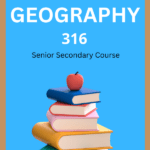NIOS Class 12 Geography Chapter 3 Dynamic Surface of The Earth, Solutions to each chapter is provided in the list so that you can easily browse throughout different chapters NIOS Class 12 Geography Chapter 3 Dynamic Surface of The Earth and select need one. NIOS Class 12 Geography Chapter 3 Dynamic Surface of The Earth Question Answers Download PDF. NIOS Study Material of Class 12 Geography Notes Paper 316.
NIOS Class 12 Geography Chapter 3 Dynamic Surface of The Earth
Also, you can read the NIOS book online in these sections Solutions by Expert Teachers as per National Institute of Open Schooling (NIOS) Book guidelines. These solutions are part of NIOS All Subject Solutions. Here we have given NIOS Class 12 Geography Chapter 3 Dynamic Surface of The Earth, NIOS Senior Secondary Course Geography Solutions for All Chapter, You can practice these here.
Dynamic Surface of The Earth
Chapter: 3
GEOGRAPHY
TEXTUAL QUESTION & ANSWER
INTEXT QUESTION 3.1
Q. Fill in the blanks:
1. Isostasy means_______.
Ans: The state of being balance.
2. Airy considered the density of different columns to be ________.
Ans: Same.
3. Pratt considered landblocks of various height to be different in terms of their________.
Ans: Density.
4. According to Airy there is ________ root below the mountain and _______ beneath the plain.
Ans: Deeper, lower.
5. Pratt postulated the concept of _______ root formation but a________ of compensation.
Ans: No, level.
6. Endogenetic forces often________ the crustal balance.
Ans: Disturb.
7. Regular earthquakes and volcanic eruptions along a particular belt does not signify________ but a sort of continuous ________.
Ans. Any balance, adjustment is needed.
INTEXT QUESTIONS 3.2
Q.1. Fill in the blanks:
(a) Alfred Wegener termed the super continent as_______.
Ans: Pangaea.
(b) Primordial ocean was known as _______.
Ans: Panthalasa.
(c) Pangaea was broken into two_______ in the north and _______ in the south.
Ans: Lauresia (Angaraland), Gondwanaland.
(d) North and south America drifted towards ________.
Ans: west.
(e) Tethys sea emerged between _______ and ______ by filling up of the water of _______.
Ans: Angaraland, Gondwanaland, Panthalasa.
Q.2. Name three evidences of continental drift put forwarded by Wegener.
Ans. (a) Jig saw fit.
(b) geological similarities.
(c) coal and vegetation evidences.
Q.3. Name two evidences of continental drift, put not mentioned by Wegener.
Ans. (a) Evidences from paleomagnetism.
(b) Sea floor spreading.
INTEXT QUESTIONS 3.3
Q.1. Fill in the blanks:
(a) The uppermost outer_____ layer of the earth is called_____.
Ans: solid, plate.
(b) Crust and upper part of mantle upto an average depth of ______ is ______.
Ans: 100km, solid.
(c) Lithosphere includes ______ and _____.
Ans: upper solid mantle, crust.
(d) Tectonics is sort of ______ of lithosphere plates.
Ans: movement.
(e) The concept of convectional current was first explained by_____ in _____.
Ans: Arthur Holmes, 1928-29.
(f) Convectional currents are classified into ______ and _____; they _____ and _____ respectively.
Ans: rising, falling, diverge, converge.
(g) Plate boundaries are associated with ______, ______ and ______.
Ans. newly formed mountain systems, oceanic ridge, trenches.
Q.3. Name some important minor plates.
Ans. (a) Arabian plate.
(b) Philippines plate.
(c) Cocos plate.
(d) Nazca plate.
(e) Caribbean plate.
(f) Scotia plate.
Q.4. Enumerate different types of place boundaries.
Ans. (a) Divergent boundaries.
(b) Convergent boundaries.
(c) Fracture or transform fault boundaries.

Hi! my Name is Parimal Roy. I have completed my Bachelor’s degree in Philosophy (B.A.) from Silapathar General College. Currently, I am working as an HR Manager at Dev Library. It is a website that provides study materials for students from Class 3 to 12, including SCERT and NCERT notes. It also offers resources for BA, B.Com, B.Sc, and Computer Science, along with postgraduate notes. Besides study materials, the website has novels, eBooks, health and finance articles, biographies, quotes, and more.




